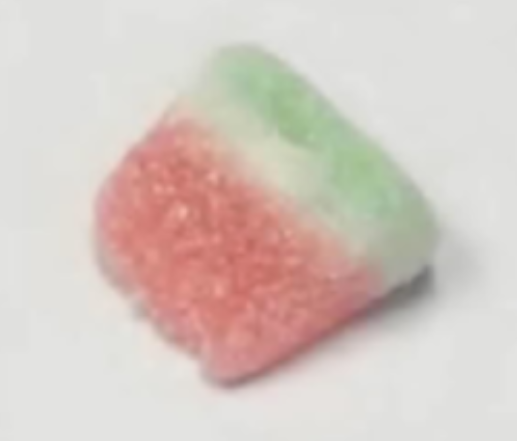Choose your trade dress carefully, if the design as a whole has any function, your trade dress may be invalid. On September 7, 2023, the Third Circuit held that a candy’s trade dress consisting of a wedge shape with red, white, and green colors was functional because the combination of the candy’s shape and colors passed the “low” bar for functionality by identifying the candy as watermelon flavored.
PIM Brands Inc. (“PIM”) registered trade dress for a piece of candy comprising of “the shape of a wedge for candy, with an upper green section with white speckles, followed by a narrow middle white section and followed by a lower red section with white speckles” that PIM called “Sour Jacks Wedges.” PIM sued Haribo of America Inc. (“Haribo”) for trademark and trade-dress infringement under the Lanham Act and for unfair competition under New Jersey common law for selling an elongated watermelon candy that is red, white, and green. Haribo asserted on summary judgment that PIM’s trade dress was functional due to its shape and color scheme. The district court agreed with Haribo, finding PIM’s trade dress registration was functional by identifying the candy as watermelon flavored. PIM appealed, arguing that the district court did not focus on the candy’s wedge shape in isolation from the candy’s colors as the shape separately identified PIM’s brand. However, PIM did admit the candy’s colors were functional because it identified a watermelon flavor.
On appeal, the Third Circuit identified how a “design is functional if it is useful for anything beyond branding.” The court explained “because the functionality bar is low” that “if a design choice ‘would put competitors at a significant non-reputation-related disadvantage,’ then the trade dress is functional.” Even a design that promotes a brand would still be functional if the design “makes a product work better.” The court rejected PIM’s argument that the district court should have analyzed the wedge’s shape in isolation from its colors because a court does not need to analyze each individual feature of a trade dress to see if it independently contributes to a certain function. The court cited to the trademark statue that when analyzing whether a trademark is functional, a court must consider the design “as a whole” 15 U.S.C. § 1052(e)(5).
Next, the court analyzed PIM’s mark as a whole and found that any reasonable juror would agree that PIM’s whole trade trades resembles a watermelon wedge. The orientation of PIM’s candy matches the orientation of an actual watermelon wedge: “each has a long, wide, green base; a thin, white layer running the length and width of the green base; and a triangular, reddish-pink top covering that white layer and angling up to a point.” The court found it did not matter that PIM’s trade dress did not exactly match a watermelon wedge, as the trade dress needed to only evoke a watermelon wedge. The court rejected PIM’s argument that the district court focused too much on the candy’s colors and not the shape because PIM’s registration was for both the color scheme and the shape of the wedge. The court held that both the color and the shape of the candy helped resemble a watermelon flavor and that function was enough to find the trade dress invalid.
In light of this decision, businesses should be careful with trade dress registration and strategy. While the Third Circuit explained that a trade dress is functional if there is a “significant non-reputation related disadvantage” the court still called functionality a “low” bar. If your trade dress, as a whole, has any function, there is a chance a court may find that the trade dress is invalid.

